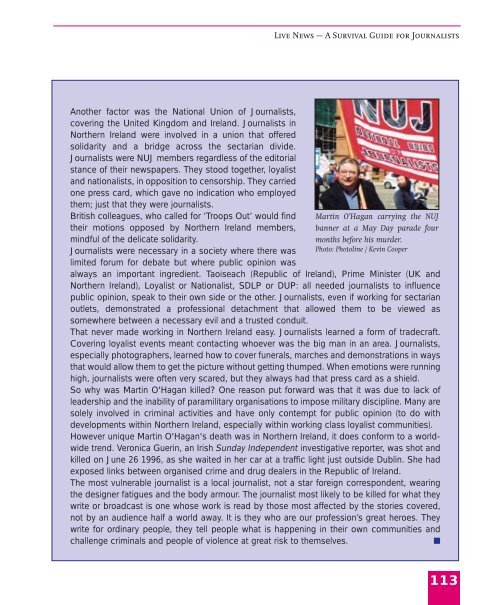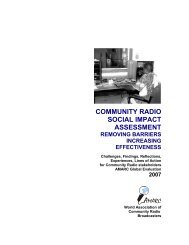Live News - A Survival Guide - International Federation of Journalists
Live News - A Survival Guide - International Federation of Journalists
Live News - A Survival Guide - International Federation of Journalists
- No tags were found...
You also want an ePaper? Increase the reach of your titles
YUMPU automatically turns print PDFs into web optimized ePapers that Google loves.
<strong>Live</strong> <strong>News</strong> — A <strong>Survival</strong> <strong>Guide</strong> for <strong>Journalists</strong>Another factor was the National Union <strong>of</strong> <strong>Journalists</strong>,covering the United Kingdom and Ireland. <strong>Journalists</strong> inNorthern Ireland were involved in a union that <strong>of</strong>feredsolidarity and a bridge across the sectarian divide.<strong>Journalists</strong> were NUJ members regardless <strong>of</strong> the editorialstance <strong>of</strong> their newspapers. They stood together, loyalistand nationalists, in opposition to censorship. They carriedone press card, which gave no indication who employedthem; just that they were journalists.British colleagues, who called for ‘Troops Out’ would findtheir motions opposed by Northern Ireland members,mindful <strong>of</strong> the delicate solidarity.<strong>Journalists</strong> were necessary in a society where there waslimited forum for debate but where public opinion wasMartin O’Hagan carrying the NUJbanner at a May Day parade fourmonths before his murder.Photo: Photoline / Kevin Cooperalways an important ingredient. Taoiseach (Republic <strong>of</strong> Ireland), Prime Minister (UK andNorthern Ireland), Loyalist or Nationalist, SDLP or DUP: all needed journalists to influencepublic opinion, speak to their own side or the other. <strong>Journalists</strong>, even if working for sectarianoutlets, demonstrated a pr<strong>of</strong>essional detachment that allowed them to be viewed assomewhere between a necessary evil and a trusted conduit.That never made working in Northern Ireland easy. <strong>Journalists</strong> learned a form <strong>of</strong> tradecraft.Covering loyalist events meant contacting whoever was the big man in an area. <strong>Journalists</strong>,especially photographers, learned how to cover funerals, marches and demonstrations in waysthat would allow them to get the picture without getting thumped. When emotions were runninghigh, journalists were <strong>of</strong>ten very scared, but they always had that press card as a shield.So why was Martin O'Hagan killed? One reason put forward was that it was due to lack <strong>of</strong>leadership and the inability <strong>of</strong> paramilitary organisations to impose military discipline. Many aresolely involved in criminal activities and have only contempt for public opinion (to do withdevelopments within Northern Ireland, especially within working class loyalist communities).However unique Martin O'Hagan's death was in Northern Ireland, it does conform to a worldwidetrend. Veronica Guerin, an Irish Sunday Independent investigative reporter, was shot andkilled on June 26 1996, as she waited in her car at a traffic light just outside Dublin. She hadexposed links between organised crime and drug dealers in the Republic <strong>of</strong> Ireland.The most vulnerable journalist is a local journalist, not a star foreign correspondent, wearingthe designer fatigues and the body armour. The journalist most likely to be killed for what theywrite or broadcast is one whose work is read by those most affected by the stories covered,not by an audience half a world away. It is they who are our pr<strong>of</strong>ession’s great heroes. Theywrite for ordinary people, they tell people what is happening in their own communities andchallenge criminals and people <strong>of</strong> violence at great risk to themselves.■113
















